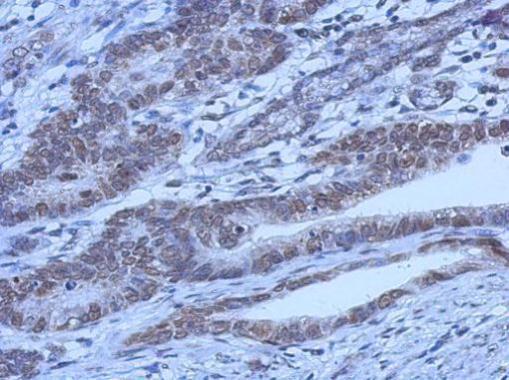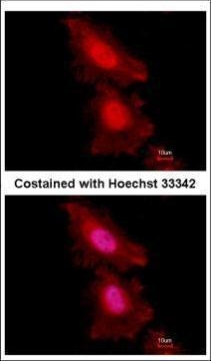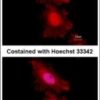Anti-FKHR Antibody (3338)
$503.00
SKU: 3338
Categories: Antibody Products, Cancer Research Antibodies, Products
Overview
Product Name Anti-FKHR Antibody (3338)
Description Anti-FKHR Mouse Monoclonal Antibody
Target FKHR
Species Reactivity Human
Applications WB,ICC/IF,IHC-P
Host Mouse
Clonality Monoclonal
Clone ID 7H3
Isotype IgG1
Immunogen GST fusion protein containing the region encoding aa 242-655 of human FKHR expressed in E. coli.
Properties
Form Liquid
Concentration Lot Specific
Formulation PBS, pH 7.4.
Buffer Formulation Phosphate Buffered Saline
Buffer pH pH 7.4
Format Purified
Purification Purified by Protein G affinity chromatography
Specificity Information
Specificity This antibody recognizes human FKHR/FOX01.
Target Name Forkhead box protein O1
Target ID FKHR
Uniprot ID Q12778
Alternative Names Forkhead box protein O1A, Forkhead in rhabdomyosarcoma
Gene Name FOXO1
Gene ID 2308
Accession Number NP_002006
Sequence Location Cytoplasm, Nucleus
Biological Function Transcription factor that is the main target of insulin signaling and regulates metabolic homeostasis in response to oxidative stress (PubMed:10358076, PubMed:12228231, PubMed:15220471, PubMed:15890677, PubMed:18356527, PubMed:19221179, PubMed:20543840, PubMed:21245099). Binds to the insulin response element (IRE) with consensus sequence 5'-TT[G/A]TTTTG-3' and the related Daf-16 family binding element (DBE) with consensus sequence 5'-TT[G/A]TTTAC-3' (PubMed:10358076). Activity suppressed by insulin (PubMed:10358076). Main regulator of redox balance and osteoblast numbers and controls bone mass (By similarity). Orchestrates the endocrine function of the skeleton in regulating glucose metabolism (By similarity). Also acts as a key regulator of chondrogenic commitment of skeletal progenitor cells in response to lipid availability: when lipids levels are low, translocates to the nucleus and promotes expression of SOX9, which induces chondrogenic commitment and suppresses fatty acid oxidation (By similarity). Acts synergistically with ATF4 to suppress osteocalcin/BGLAP activity, increasing glucose levels and triggering glucose intolerance and insulin insensitivity (By similarity). Also suppresses the transcriptional activity of RUNX2, an upstream activator of osteocalcin/BGLAP (By similarity). In hepatocytes, promotes gluconeogenesis by acting together with PPARGC1A and CEBPA to activate the expression of genes such as IGFBP1, G6PC1 and PCK1 (By similarity). Important regulator of cell death acting downstream of CDK1, PKB/AKT1 and STK4/MST1 (PubMed:18356527, PubMed:19221179). Promotes neural cell death (PubMed:18356527). Mediates insulin action on adipose tissue (By similarity). Regulates the expression of adipogenic genes such as PPARG during preadipocyte differentiation and, adipocyte size and adipose tissue-specific gene expression in response to excessive calorie intake (By similarity). Regulates the transcriptional activity of GADD45A and repair of nitric oxide-damaged DNA in beta-cells (By similarity). Required for the autophagic cell death induction in response to starvation or oxidative stress in a transcription-independent manner (PubMed:20543840). Mediates the function of MLIP in cardiomyocytes hypertrophy and cardiac remodeling (By similarity). Regulates endothelial cell (EC) viability and apoptosis in a PPIA/CYPA-dependent manner via transcription of CCL2 and BCL2L11 which are involved in EC chemotaxis and apoptosis (PubMed:31063815). {UniProtKB:A4L7N3, UniProtKB:G3V7R4, UniProtKB:Q9R1E0, PubMed:10358076, PubMed:12228231, PubMed:15220471, PubMed:15890677, PubMed:18356527, PubMed:19221179, PubMed:20543840, PubMed:21245099, PubMed:31063815}.
Research Areas Cancer Research
Background FKHR (ForKHead in Rhabdomyosarcoma), a 70kDa protein, is a member of the forkhead family of transcription factors. Members of this family are classified by their degree of homology in the 100-120aa region that is necessary for DNA binding and binding-site specificity. The FKHR subfamily differs from other members of the forkhead family in that all members contain an insertion of 5 amino acids next to the helix 3 in the middle of the forkhead domain and lack the conserved amino terminal KPPY sequence found in most forkhead genes. It has been shown that members of the FKHR gene family are phosphorylated by Akt which regulates its cellular localization promoting cell survival.
Application Images



Description Immunohistochemical analysis of paraffin-embedded Colon ca, using FOXO1(3338) antibody at 1:50 dilution.

Description Immunofluorescence analysis of paraformaldehyde-fixed HeLa, using FOXO1(3338) antibody at 1:100 dilution.
Handling
Storage This antibody is stable for at least one (1) year at -20°C or below. Store undiluted product in appropriate aliquots to avoid multiple freeze-thaw cycles.
Dilution Instructions Dilute in PBS or medium that is identical to that used in the assay system.
Application Instructions Immunoblotting: use at 0.1-2.0ug/mL. A band of 70kDa is detected.
Endusers should determine optimal concentrations for their applications.
Endusers should determine optimal concentrations for their applications.
References & Data Sheet
Data Sheet  Download PDF Data Sheet
Download PDF Data Sheet
 Download PDF Data Sheet
Download PDF Data Sheet





